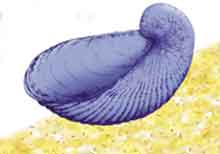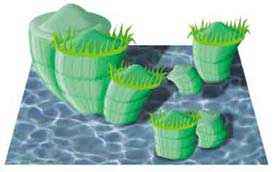Bivalves

Bivalves have inhabited the Earth for over 500 million years. They first appeared in the Middle Cambrian, about 300 million years before the dinosaurs. They flourished in the Mesozoic and Cainozoic eras, and abound in modern seas and oceans; their shells litter beaches across the globe.

In life, bivalve shells are made from layers of crystals of the minerals calcite or aragonite, which are the two different mineral forms of calcium carbonate (CaCO3). Fossil bivalves were formed when the sediment in which they were buried hardened into rock. Many closely resemble living forms which helps us to understand how they must have lived.
Bivalves, which belong to the phylum Mollusca and class Bivalvia, have two hard, usually bowl-shaped, shells (called valves) enclosing the soft body. The valves are the parts usually found as fossils, but decay of the elastic hinge tissue that joins them means that they are rarely preserved together.


The inside surface of a bivalve shell is marked by the attachment areas of the muscles and ligament responsible for opening and closing the valves. These features, with the teeth and sockets of the hinge, are important for classification.


In the Late Cretaceous, rudist bivalves with strangely-shaped conical right valves up to 50 centimetres high, formed coral- like reefs across southern Europe and north Africa, but like many other fossil groups, they suddenly became extinct at the end of the Cretaceous Period.